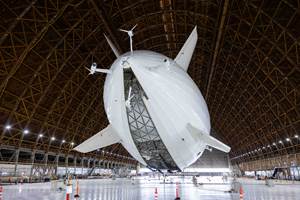Blue Origin successfully tests escape system, lands New Shepard rocket
On Oct. 5, the company successfully conducted an in-flight escape test of its New Shepard system.
Blue Origin warned its next flight was going to be dramatic, no matter how it ended. So Oct. 5 was a good news day for the company as it successfully conducted an in-flight escape test of its New Shepard system, which is a fully reusable rocket and capsule. Everything went according to plan, taking the company one big step toward its goal of carrying people into space.
According to Space.com:
New Shepard blasted off from Blue Origin's test range in west Texas at 11:36 a.m. EDT (1536 GMT), kicking off today's uncrewed test. About 45 seconds into flight, at an altitude of 16,000 feet (5,000 meters), the capsule fired its onboard "escape motor" for 2 seconds, blasting itself hundreds of feet clear of the booster.
Blue Origin owner and billionaire entrepreneur Jeff Bezos wrote last month in a blog article that this flight would be its toughest test yet:
About 45 seconds after liftoff at about 16,000 feet, we’ll intentionally command escape. Redundant separation systems will sever the crew capsule from the booster at the same time we ignite the escape motor. The escape motor will vector thrust to steer the capsule to the side, out of the booster’s path. The high acceleration portion of the escape lasts less than two seconds, but by then the capsule will be hundreds of feet away and diverging quickly. It will traverse twice through transonic velocities – the most difficult control region – during the acceleration burn and subsequent deceleration. The capsule will then coast, stabilized by reaction control thrusters, until it starts descending. Its three drogue parachutes will deploy near the top of its flight path, followed shortly thereafter by main parachutes.
Space.com wrote:
At 11:41 a.m. EDT (1541 GMT), the New Shepard capsule landed softly under parachutes in the Texas desert as planned, raising a huge plume of dust as it hit the ground.
And of the booster? About three minutes later, the booster landed vertically on the launch pad. Bezos had predicted earlier the test would destroy it:
We’d really like to retire it after this test and put it in a museum. Sadly, that’s not likely. This test will probably destroy the booster. The booster was never designed to survive an in-flight escape. The capsule escape motor will slam the booster with 70,000 pounds of off-axis force delivered by searing hot exhaust. The aerodynamic shape of the vehicle quickly changes from leading with the capsule to leading with the ring fin, and this all happens at maximum dynamic pressure. Nevertheless, the booster is very robust and our Monte Carlo simulations show there’s some chance we can fly through these disturbances and recover the booster. If the booster does manage to survive this flight – its fifth – we will in fact reward it for its service with a retirement party and put it in a museum. In the more likely event that we end up sacrificing the booster in service of this test, it will still have most of its propellant on board at the time escape is triggered, and its impact with the desert floor will be most impressive.
"Wow. There it is. There you go, New Shepard. Look at her," launch commentator Ariane Cornell said once the booster landed. "What an extraordinary test and a tremendous final flight for both craft."
Check out video of the in-flight escape test below:
Related Content
Cryo-compressed hydrogen, the best solution for storage and refueling stations?
Cryomotive’s CRYOGAS solution claims the highest storage density, lowest refueling cost and widest operating range without H2 losses while using one-fifth the carbon fiber required in compressed gas tanks.
Read MoreNext-generation airship design enabled by modern composites
LTA Research’s proof-of-concept Pathfinder 1 modernizes a fully rigid airship design with a largely carbon fiber composite frame. R&D has already begun on higher volume, more automated manufacturing for the future.
Read MoreWelding is not bonding
Discussion of the issues in our understanding of thermoplastic composite welded structures and certification of the latest materials and welding technologies for future airframes.
Read MorePlant tour: Albany Engineered Composites, Rochester, N.H., U.S.
Efficient, high-quality, well-controlled composites manufacturing at volume is the mantra for this 3D weaving specialist.
Read MoreRead Next
Plant tour: Daher Shap’in TechCenter and composites production plant, Saint-Aignan-de-Grandlieu, France
Co-located R&D and production advance OOA thermosets, thermoplastics, welding, recycling and digital technologies for faster processing and certification of lighter, more sustainable composites.
Read MoreDeveloping bonded composite repair for ships, offshore units
Bureau Veritas and industry partners issue guidelines and pave the way for certification via StrengthBond Offshore project.
Read More“Structured air” TPS safeguards composite structures
Powered by an 85% air/15% pure polyimide aerogel, Blueshift’s novel material system protects structures during transient thermal events from -200°C to beyond 2400°C for rockets, battery boxes and more.
Read More


























